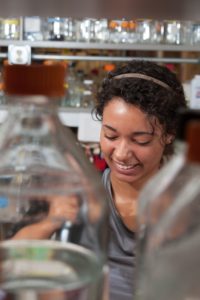The population of students in the STEM disciplines (science, technology, engineering, and mathematics) does not always reflect the general student population. Historically women and minorities have made up a far smaller proportion of the student body and workforce in these areas. But organizations, including Colorado State University, are working to chip away at these disparities – from the lab up.

A longstanding consortium of Colorado schools, known as the Colorado Louis Stokes Alliance for Minority Participation, has supported on-campus work to increase the numbers of underrepresented students in STEM. And a new, five-year award of $4.8 million from the National Science Foundation has expanded the program, creating the Colorado-Wyoming Louis Stokes Alliance for Minority Participation. The new support increases the number of participating institutions to 16 across Colorado and Wyoming, which covers nearly every major research school in the region, including CSU, Colorado School of Mines, all University of Colorado campuses, the University of Denver, University of Wyoming, and others.
“Even though the grant resides here at CSU, it is truly a Colorado-Wyoming alliance,” said Ernest Chavez, a professor of psychology in the College of Natural Sciences and director of the program (Chavez also leads the related National Institutes of Health-funded Bridges to Baccalaureate program at CSU). In particular, he said, “part of the hope in including Wyoming is to increase our outreach to American Indian students to the two major reservations there.” And he is excited to bring a wealth of opportunities to all underrepresented students interested in STEM in the two states.
Find opportunities for students here.
Into the lab
For the first year of the expanded program, which begins this semester, one of the key focuses will be on undergraduate research. This experience is considered a “high-impact practice” that increases students’ likelihood of finishing their degrees. “The evidence is very clear that the earlier students get involved in research – especially in the sciences – the higher the probability that they will remain in their major and will graduate in their major,” Chavez said.
For many students, however, devoting extra time outside of class to lab research isn’t economically feasible.
To combat that challenge, part of the grant will go to enlarging regional participation in Research Experiences for Undergraduates, an NSF-run program. In this program, undergraduates can apply to spend 10 weeks at a lab at one of the consortium institutions, where they will receive free lodging, as well as a stipend.
“Underrepresented students are more likely to be first-generation [college students],” Chavez said. “And first-generation students are more likely to have to work during the summer. This is a livable wage that would allow them to focus on research for that summer.”
Beyond graduation, “research also increases the likelihood of going to graduate school,” Chavez said. With more students of diverse backgrounds participating in these programs, he hopes that it will also help “increase the number of underrepresented folks in master’s programs,” he said.
Going global
The other central goal of this first year of funding will be to help bolster underrepresented STEM student participation in international programs, another well-documented high-impact practice that improves the likelihood of graduation.
Travel also can broaden the idea of what a STEM degree can do. “From my perspective,” Chavez said, “underrepresented students who leave the sciences often can’t see a direct relationship between their community and what they’re doing [in school].”
International opportunities, such as Engineers without Borders (EWB), can help remedy that disconnect. Through EWB, students travel to a community outside of the country for four to six weeks to facilitate the development of clean water systems, septic systems, or other infrastructure that might be needed, putting their engineering skills to work. Part of the NSF grant will go to making these programs accessible to more students by paying for their travel.
Gaining this sort of hands-on volunteer experience, Chavez said, “shows directly how science is making a difference in people’s lives right now – with an international opportunity attached to it.”
Better together
The new grant has more than doubled the funding the program have received cumulatively in the past two decades. And with that increase comes the ability to expand and to create programs – as well as to support new connections: “We, as institutions, don’t work together as much as we should on these types of issues,” Chavez said. “Since we typically are rivals in one form or another, this is an attempt to say that ‘we all agree that this is a problem, and we’re all going to work together to increase the numbers across all of our institutions.’”
Chavez plans to track participation and success rates – and fine-tuning programs so that they have the most impact. Looking ahead to the next five years, he is optimistic: “If anybody can make a difference, we can,” he said.